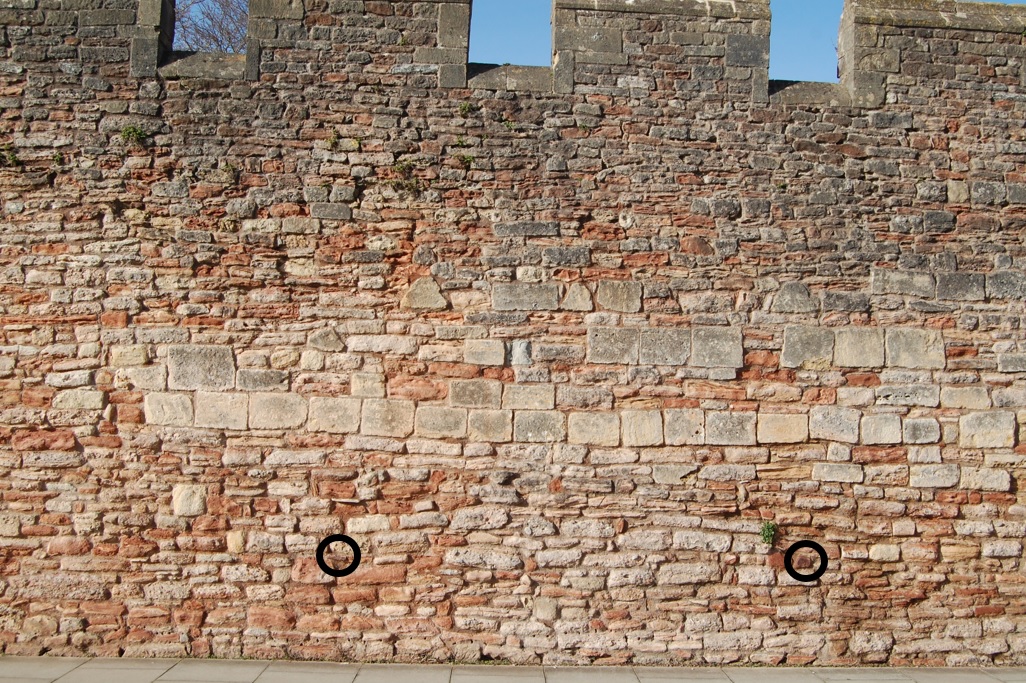Find the stone wall between the Old Deanery entrance and the Wells and Mendip Museum on Cathedral Close, opposite the cathedral in Wells. The wall is around 4m high and has crenulations (battlements). The building stones of this wall have four different geological ages, but all are found in the Wells area.
The most common stone is the Triassic rock around 240 million years old; this is usually rusty red and contains lots of broken fragments of other rock. About 240 million years ago, the area was a desert; when there were desert storms, floods picked up the rock fragments and sands from the desert floor and dumped them when the water currents slowed down.
The next most common stone is the yellow ochre-coloured Jurassic limestone, of around 165 million years old, often in rectangular blocks. The rock was laid down when this area was a shallow sub-tropical sea, around 165 million years ago, where lots of shelly animals lived. When they died, they were broken up by waves and currents and laid down as layers of lime sand, which later became limestone. The same stone is the main building stone of the cathedral opposite.
Carboniferous limestone of about 340 million years old is the next most common rock. It is a pale to dark grey rock that can be found as one or two separate stones, but is the most common type of rock fragment in the Triassic rock. This also contains fossil fragments and was deposited in an equatorial shallow sea, in much the same way as the Jurassic limestone.
The wall contains one or two stones that are of Devonian age, about 420 million years old (circled on the photograph). This rock, sometimes called Old Red Sandstone, is usually a deep reddish-brown colour. It was laid down by rivers when the area was a desert around 420 million years ago; desert sands are commonly red in colour from their high iron oxide content.

To answer question 5 below, you will need to know that the Earth today, and in the geological past when these sedimentary rocks were laid down, has/had these climatic zones:
- Polar – near the North pole
- Cool temperate
- Warm temperate – Britain today
- Sub-tropical
- Hot desert
- Equatorial – across the Equator
- Hot desert
- Sub-tropical
- Warm temperate
- Cool temperate
- Polar – near the South pole
To answer question 5 you also need to know about the plate tectonics. This shows that the outer part of the Earth is made of huge plates that move. In some parts of the Earth, new plate material is being added and in other areas, plates are taken down into the deep Earth. Plates move across the surface from where the new plate is being formed to where it goes back into the Earth. As plates move, they carry continents with them; sometimes this can cause continents to collide, producing great mountain ranges like the Himalayas.
The four different rocks in questions 1 – 4 contain sands and fragments of different sizes. The largest fragments found in the rocks are:
- less than 2 mm across (less than the size of a letter in one of the words on the front of a 1p (one penny) coin);
- between 2 and 10 mm across (between the size of a letter in one of the words and the size of the Queen’s head on the front of a 1p coin);
- between 10 and 20 mm across (between the size of the Queen’s head on a 1p coin and the size of the coin itself);
- more than 20 mm across (bigger than the size of a 1p coin).
What to do
Of the sizes given above, what is the size of the largest sand/grain or fragment of rock or fossil you can find in the:
- rusty red Triassic rock?
- yellow ochre-coloured Jurassic limestone?
- grey Carboniferous limestone?
- reddish-brown Devonian rock?
- How is it possible that, while the climate in Britain today is temperate, the evidence of these local rocks shows that:
- around 165 million years ago, the Jurassic climate here was sub-tropical
- about 240 million years ago, in Triassic times, the area had a desert climate
- around 340 million years ago, in the Carboniferous, the climate was equatorial
- about 420 million years ago, during Devonian times, this area had a desert climate
Please email your answers to me JurassicEdie or send your answers through the Message Centre.